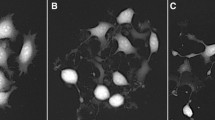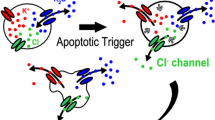Abstract
Cell shrinkage is a hallmark of apoptosis. Potassium efflux, which is involved in cell shrinkage, has been previously described as an essential event of apoptosis. This study was designed to address the importance of potassium efflux in hypertonicity (450 mOsm and 600 mOsm) induced apoptosis. We initiated apoptosis in HL-60 cells in hypertonic medium consisting of either high concentrations of NaCl, mannitol or KCl. Apoptotic activity was evaluated based on the DNA content of the cells, annexin-V staining and calcium content. Apoptosis was initiated in hypertonic conditions consisting of high intracellular K+. We demonstrate that apoptosis can occur in the presence of high intracellular potassium contrary to previous predictions.






Similar content being viewed by others
Abbreviations
- RVD:
-
regulatory volume decrease
- RVI:
-
regulatory volume increase
- AVD:
-
apoptotic volume decrease
References
Bortner CD, Cidlowski JA (2002) Apoptotic volume decrease and the incredible shrinking cell. Cell Death Differ 9:1307–1310
Hallows KR, Packman CH, Knauf PA (1991) Acute cell volume changes in anisotonic media affect F-actin content of HL-60 cells. Am J Physiol 261:C1154–1161
Okada Y, Maeno E, Shimizu T, Dezaki K, Wang J, Morishima S (2001) Receptor-mediated control of regulatory volume decrease (RVD) and apoptotic volume decrease (AVD). J Physiol 532:3– 16
Small DL, Tauskela J, Xia Z (2002) Role for chloride but not potassium channels in apoptosis in primary rat cortical cultures. Neurosci Lett 334:95–98
Maeno E, Shimizu T, Okada Y (2006) Normotonic cell shrinkage induces apoptosis under extracellular low Cl conditions in human lymphoid and epithelial cells. Acta Physiol (Oxf) 187:217– 222
Burg ED, Remillard CV, Yuan JX (2006) K+ channels in apoptosis. J Membr Biol 209:3–20
Gallin EK, Mason TM, Moran A (1994) Characterization of regulatory volume decrease in the THP-1 and HL-60 human myelocytic cell lines. J Cell Physiol 159:573–581
Maeno E, Ishizaki Y, Kanaseki T, Hazama A, Okada Y (2000) Normotonic cell shrinkage because of disordered volume regulation is an early prerequisite to apoptosis. Proc Natl Acad Sci USA 97:9487–9492
Bortner CD, Hughes FM Jr, Cidlowski JA (1997) A primary role forK+ and Na+ efflux in the activation of apoptosis. J Biol Chem 272:32436–32442
Gantner F, Uhlig S, Wendel A (1995) Quinine inhibits release of tumor necrosis factor, apoptosis, necrosis and mortality in a murine model of septic liver failure. Eur J Pharmacol 294:353–355
Hallows KR, Knauf PA (1994) Regulatory volume decrease in HL-60 cells: importance of rapid changes in permeability of Cl- and organic solutes. Am J Physiol 267:C1045–1056
Bortner CD, Cidlowski JA (1996) Absence of volume regulatory mechanisms contributes to the rapid activation of apoptosis in thymocytes. Am J Physiol 271:C950–961
June CH, Abe R, Rabinovitch PS (1995) Measurment of intracellular ions by flowcytometry. In: Coligan JE, Kruisbeek AM, Margulies DH, Shevach EM, Strober W (eds) Current protocols in immunology. John Wiley & Sons, Inc., New York
Schmid I, Uittenbogaart CH, Giorgi JV (1994) Sensitive method for measuring apoptosis and cell surface phenotype in human thymocytes by flow cytometry. Cytometry 15:12–20
Vermes I, Haanen C, Steffens-Nakken H, Reutelingsperger C (1995) A novel assay for apoptosis. Flow cytometric detection of phosphatidylserine expression on early apoptotic cells using fluorescein labelled Annexin V. J Immunol Methods 184:39– 51
Moore A, Donahue CJ, Bauer KD, Mather JP (1998) Simultaneous measurement of cell cycle and apoptotic cell death. Meth Cell Biol 57:265–278
Martin SJ, Finucane DM, Amarante-Mendes GP, O’Brien GA, Green DR (1996) Phosphatidylserine externalization during CD95-induced apoptosis of cells and cytoplasts requires ICE/CED-3 protease activity. J Biol Chem 271:28753–28756
Yu SP, Choi DW (2000) Ions, cell volume, and apoptosis. Proc Natl Acad Sci USA 97:9360–9362
Trimarchi JR, Liu L, Smith PJ, Keefe DL (2002) Apoptosis recruits two-pore domain potassium channels used for homeostatic volume regulation. Am J Physiol Cell Physiol 282:C588–594
McCarthy JV, Cotter TG (1997) Cell Shrinkage and apoptosis: a role for potassium and sodium ion efflux. Cell death and differentiation 4:756–770
Gomez-Angelats M, Bortner CD, Cidlowski JA (2000) Cell volume regulation in immune cell apoptosis. Cell Tissue Res 301:33– 42
Bortner CD, Cidlowski JA (1998) A necessary role for cell shrinkage in apoptosis. Biochem Pharmacol 56:1549–1559
Gomez-Angelats M, Cidlowski JA (2002) Cell volume control and signal transduction in apoptosis. Toxicol Pathol 30:541–551
Dallaporta B, Hirsch T, Susin SA et al (1998) Potassium leakage during the apoptotic degradation phase. J Immunol 160:5605–5615
Lewis RS, Cahalan MD (1995) Potassium and calcium channels in lymphocytes. Annu Rev Immunol 13:623–653
Choi BY, Kim HY, Lee KH, Cho YH, Kong G (1999) Clofilium, a potassium channel blocker, induces apoptosis of human promyelocytic leukemia (HL-60) cells via Bcl-2-insensitive activation of caspase-3. Cancer Lett 147:85–93
Rabinowitz JD, Rigler P, Carswell-Crumpton C, Beeson C, McConnell HM (1997) Screening for novel drug effects with a microphysiometer: a potent effect of clofilium unrelated to potassium channel blockade. Life Sci 61:PL87–94
Burg M (2000) Macromolecular crowding as a cell volume sensor. Cell Physiol Biochem 10:251–256
Eggers DK, Valentine JS (2001) Crowding and hydration effects on protein conformation: a study with sol-gel encapsulated proteins. J Mol Biol 314:911–922
Rizoli SB, Rotstein OD, Kapus A (1999) Cell volume-dependent regulation of L-selectin shedding in neutrophils. A role for p38 mitogen-activated protein kinase. J Biol Chem 274:22072–22080
Frasch SC, Nick JA, Fadok VA, Bratton DL, Worthen GS, Henson PM (1998) p38 mitogen-activated protein kinase-dependent and -independent intracellular signal transduction pathways leading to apoptosis in human neutrophils. J Biol Chem 273:8389–8397
Acknowledgments
We thank Joanne Schultz and Foon-Yee Law for their excellent technical assistance. We would also like to thank Dr. Mary Lou Vallano, Dr. Kristen Nubia Kaba, Dr. Roman Eliseev, and Dr. Thomas Gunter for helpful discussions and suggestions. This study was supported by the National Institutes of Health grants HL-18208, Strong Children's Hospital Summer Research Program and DK-27495.
Author information
Authors and Affiliations
Corresponding author
Rights and permissions
About this article
Cite this article
Ghosh, A., Keng, P.C. & Knauf, P.A. Hypertonicity induced apoptosis in HL-60 cells in the presence of intracellular potassium. Apoptosis 12, 1281–1288 (2007). https://doi.org/10.1007/s10495-007-0054-z
Published:
Issue Date:
DOI: https://doi.org/10.1007/s10495-007-0054-z




